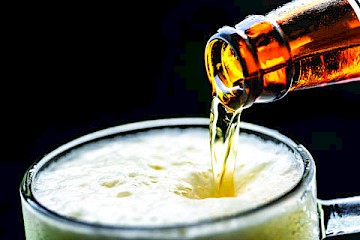Aeration and Foam: Good for Beer, Bad for Oil
 In the industrial maintenance and reliability field, it’s safe to assume that we’re the type of people that enjoy a cold one on Friday after a hard work week. Early on, I didn’t like a lot of foam on my beer, and many others think the same way. After further research, I learned that you actually do want a little foam on top of your beer; it enhances the flavor of the beer by producing different aromas and taste profiles that wouldn’t exist in a flat, airless beer. It also provides a level of insulation to keep the drink cooler longer. In an industrial oil, some air in the oil is quite common. Foam, however, is typically a problem and should not show up in your industrial oil. Foam can lead to a vast array of different problems and, unlike beer, has no enhancing properties for the oil.
In the industrial maintenance and reliability field, it’s safe to assume that we’re the type of people that enjoy a cold one on Friday after a hard work week. Early on, I didn’t like a lot of foam on my beer, and many others think the same way. After further research, I learned that you actually do want a little foam on top of your beer; it enhances the flavor of the beer by producing different aromas and taste profiles that wouldn’t exist in a flat, airless beer. It also provides a level of insulation to keep the drink cooler longer. In an industrial oil, some air in the oil is quite common. Foam, however, is typically a problem and should not show up in your industrial oil. Foam can lead to a vast array of different problems and, unlike beer, has no enhancing properties for the oil.
Foam is extremely difficult to deal with. It can lead to false oil level readings and overall decreased performance, which can cause the machine to the airlock. Small amounts of foam aren’t necessarily detrimental, but if gone unmonitored, it can ultimately lead to failure. Foam is always a problem when the oil level can no longer be controlled or when the foam is doing the lubricating instead of the oil itself.
Four Phases of Air in an Industrial Oil
 1. Free Air
1. Free Air
Free air is the air often found in the headspace of a reservoir, but it can also be trapped within the system in various places. Free air can be especially troublesome in systems that depend on fluid pressure to operate (i.e., a hydraulic system). If the brake lines on your car or truck have some free air trapped in the line, it will produce a spongy brake pedal; apply the same logic to a hydraulic system. It can also lead to vapour lock and restrict the movement of fluid.
Free air is the air that has not necessarily mixed with the oil yet. This air moves in and out of the reservoir quite easily, through the breather, labyrinth seal, or even an air leak in the reservoir. Free air is also the easiest air to remove.
 2. Dissolved Air
2. Dissolved Air
Dissolved air is very common in most oils. This is when the air bubbles are microscopic; they are not detectable by your naked eye. One thing to note about dissolved air is that it needs to be degassed before performing any optical particle count; it can cause a false reading. High levels of dissolved air can also lead to an increased oxidation rate.
 3. Entrained Air
3. Entrained Air
Typically, this is the worst-case scenario. You will know when there is entrained air in the oil: the oil will look very milky and discoloured. This occurs when you have small air bubbles suspended throughout the fluid. These bubbles take a long time to rise to the surface and produce an oil that is more spongy. Entrained air can lead to cavitation, micro-dieseling and many other serious problems.
 4. Foam
4. Foam
Foam is generally caused by overfilling, impaired air handling properties, contamination or mechanical problems. Referring back to the automotive oil analogy, if you overfill the crankcase in an engine, it will become frothy and foamy, putting excessive pressure on the crankshaft and leading to further and more damaging issues.
There are a few ways we can exclude, remove and attempt to prevent air entrainment in our industrial oils. Most quality industrial oils these days will have some sort of defoamant additive. Silicone additives and acrylate copolymers are common types of defoamants (there are no incompatibilities between the two if you are wondering). However, acrylate copolymers are pretty sensitive to certain polar contaminants, making them slightly less effective after a given period of time.
As for removal, it really depends on the source of air ingression. Most of the time, if the air ingression is aggressive enough, it could indicate improper setup of the machinery. The following are common causes of air ingression:
- The return line is above the oil level (causing splashing and trapping of that air)
- Too small of a reservoir
- Improper oil level in gearboxes
Besides additives and proper setup, there are mechanical methods of controlling air in our oil, such as baffles, diffusers, and wire mesh on the return lines. We often teach in our classes to keep a sharp eye on W.H.A.M. (Water, Heat, Air and Catalytic Metals). If we are able to control entrained air, we are often able to control foam issues. Trying to keep the oil healthy and minimize turbulence in the reservoir are key factors that should be analyzed any time a foam problem exists.
